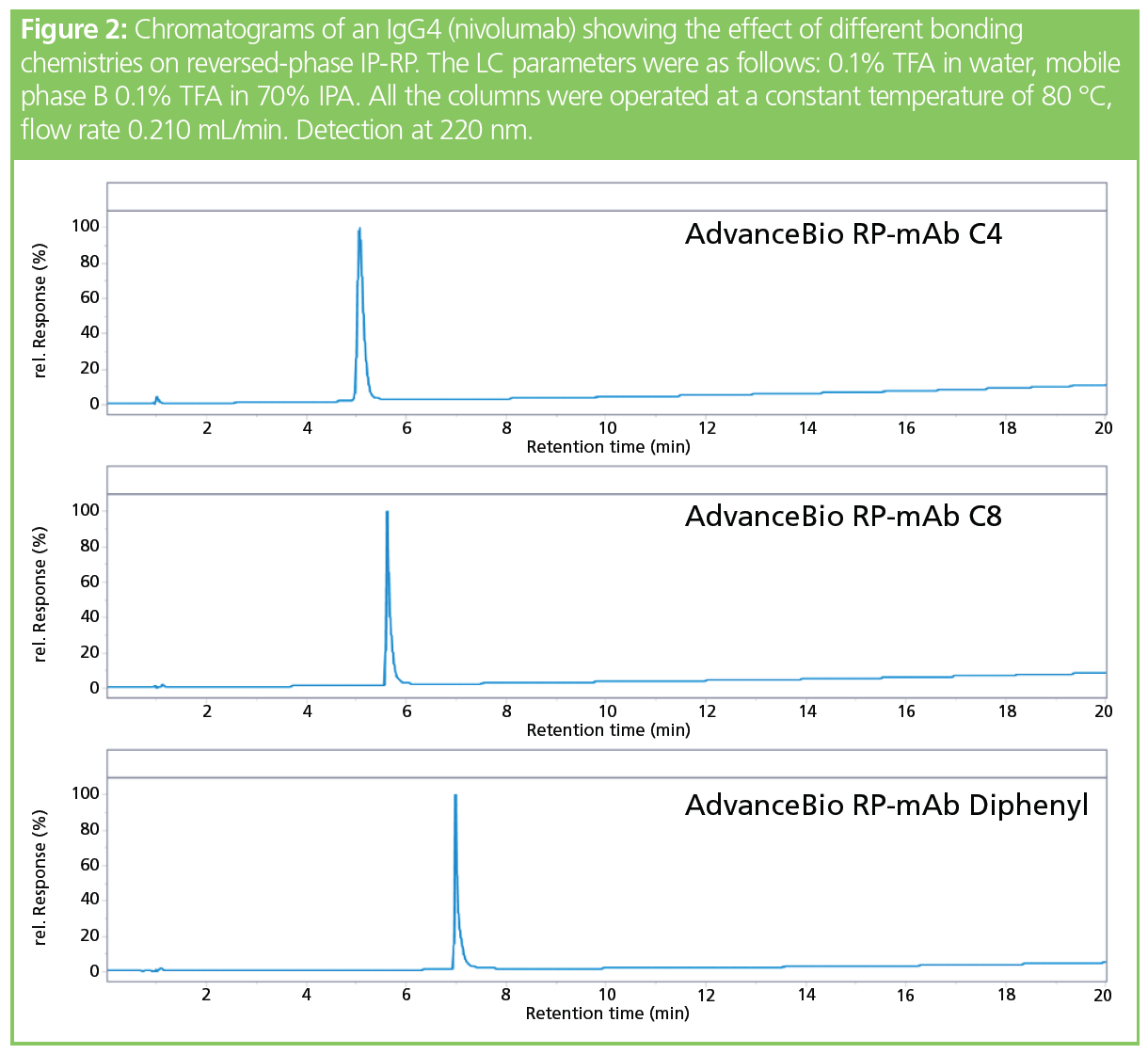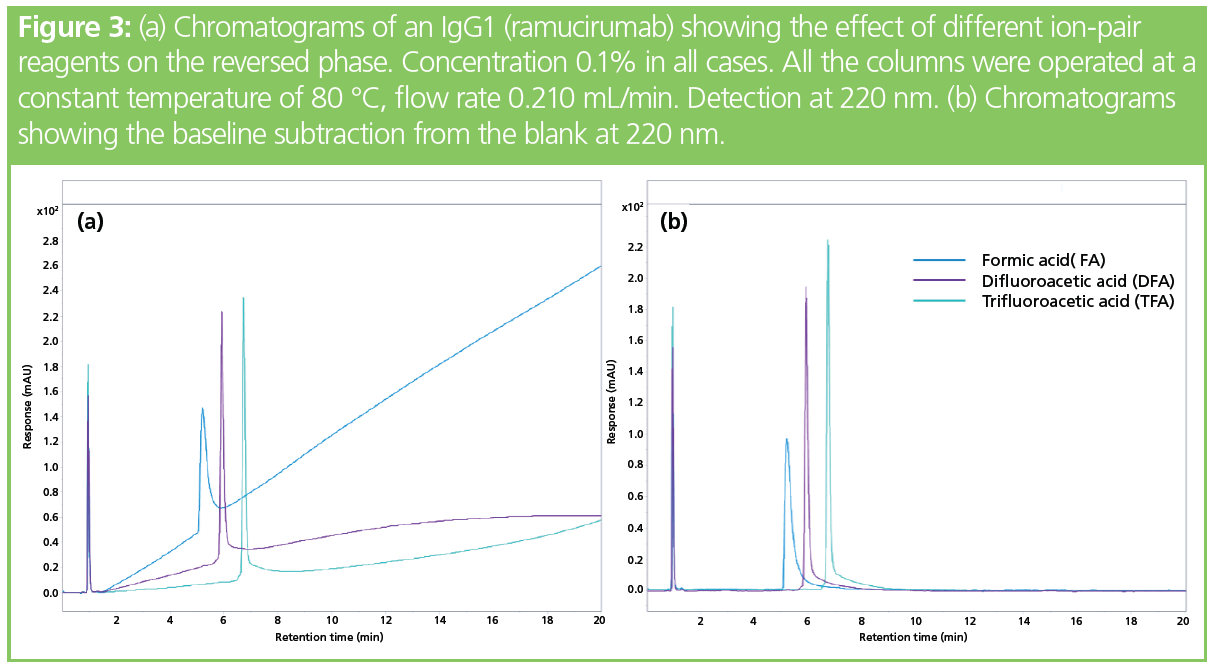Method Development Considerations for Intact Monoclonal Antibody Analysis Using UHPLC Instrumentation
This study considers the importance of column choice as well as mobile phase conditions for the study of intact monoclonal antibodies (mAbs) by reversed-phase high performance liquid chromatography (HPLC). Since each monoclonal antibody has a different isoelectric point and a different hydrophobicity, a systematic approach comparing the impact of different factors such as bonding chemistry, ion-pair reagent choice, and organic modifier is required.
Liquid chromatography (LC) has evolved considerably over the years. The drive for increased resolution and faster separations has resulted in columns packed with smaller particle-sized stationary phases, which requires the need for pumps capable of running at higher pressures and higher flow rates. Additional developments have resulted in lower extracolumn dead volumes, higher precision, and greater reproducibility, often referred to as ultrahigh-performance liquid chromatography (UHPLC).
As a biochromatographer, working with very large biomolecules such as monoclonal antibodies (with more than 1300 amino acids and around 150,000 g/mol), we can also benefit from some of these improvements. However, large biomolecules do not behave in the same way as small molecules, and some features may not lead to the same benefits.
Monoclonal antibodies, or mAbs, have become increasingly important as biotherapeutics and are manufactured by cell culture. Recombinant proteins are never 100% pure and contain numerous variants that can arise during expression, or because of upstream and downstream processes. Measuring the amount of variants present requires the use of a wealth of chromatographic techniques and can include size exclusion, ion exchange, and affinity chromatography. The most widely used technique remains reversed-phase chromatography, either to simply quantify variants using a concentration detector such as UV, or in combination with mass spectrometry (MS) to get an accurate mass.
A range of commercially available mAbs show just how varied these molecules can be. They are similar in size but with very different physical properties, such as hydrophobicity and isoelectric point. As a result, it is usually necessary to carry out a lot of method development to obtain the best separation.
Many of the reversed-phase columns that have been developed for UHPLC applications have extremely small particle sizes (< 2 µm) and therefore high operating pressures. They also often have small pore sizes. The hydrodynamic radius of a mAb is usually around 5–6 nm, meaning columns with pores that are 300 Å or larger are necessary. Sub‑2‑µm particle sizes can be detrimental for the analysis of biomolecules for several reasons. The small particle size means that the frits used to contain the stationary phase in the column can act as a filter and trap some of the components in the sample, or the shear forces generated inside the column can cause degradation of some samples.
To overcome some of these challenges, superficially porous particles designed for reversed-phase applications for mAb analysis have been developed. This stationary phase has a solid core surrounded by a thin porous shell with pores of 450 Å. This means that the overall particle size is somewhat larger than typical UHPLC columns, so frits are more permeable and shear forces are greatly reduced. The wide pore size and thin shell mean large biomolecules do not suffer from poor mass transfer and so peaks are sharper.
There are other additional challenges to overcome: choice of bonding chemistry, choice of ion-pair reagent, and choice of mobile phase.
Choice of Bonding Chemistry
Since the nature and interactions of the proteins can be different, it is important to bear in mind that various bonding chemistries may well give different results. For this reason we have been investigating different stationary phases, from a short C4 alkyl chain to a slightly longer C8 to a diphenyl bonding—the latter sometimes providing higher resolution by being more retentive. In this study we have evaluated the reversed-phase liquid chromatographic behaviour of four approved IgG mAbs (ramucirumab, nivolumab, emicizumab, and ocrelizumab).
Choice of Ion-Pair Reagent
Choosing the best ion-pair reagent is probably the most important parameter when using reversed-phase chromatography. The type of compound, its concentration, and its affinity with the solvents and detector all play a critical role when separating the analytes. Selectivity and retention time differences can be seen by comparing trifluoroacetic acid (TFA), formic acid (FA), and difluoroacetic acid (DFA). TFA is the first choice for the separation of proteins as it has excellent chromatographic characteristics and reduces unwanted interactions and the tailing factor. However, TFA can cause excessive ion suppressions when used in LC–MS applications. FA is a much weaker ion-pairing modifier, more suitable for LC–MS analysis, but the drawbacks are shorter retention times, often with broader and more tailing peaks. Using FA in LC–UV applications may also show high levels of background absorbance and greater baseline drift. DFA is slightly less acidic and hydrophobic than TFA, but may offer an improvement over the use of FA in LC–MS applications where sharper peaks may be required.
Choice of Mobile Phase
The effect of the mobile phase in reversed‑phase chromatography is critical. Normally, a typical mobile phase for mAb analysis by ion-pair reversed-phase (IP‑RP) contains acetonitrile, but sometimes this can lead to lower recovery, increased peak tailing, and carryover. For this reason, to reduce the secondary interactions and increase the protein recovery, organic alcohols such as 2-propanol and n-butanol were chosen. Both reagents gave improved chromatographic performance by having much higher eluotropic values.
Experimental
Samples: The intact therapeutic mAbs were diluted to 1 mg/mL with water and injected, with no further sample preparation needed. Method: The columns used for this study were a 2.1 × 100 mm, 3.5-µm AdvanceBio RP-mAb C4, 2.1 × 100 mm, 3.5-µm AdvanceBio RP-mAb SB-C8, and AdvanceBio RP-mAb Diphenyl 2.1 × 100 mm, 3.5-µm (all Agilent). All the columns were operated at 80 °C. The flow rate was 0.210 mL/min.
Mobile phase A was water containing TFA 0.1%. Mobile phase B consisted of 0.1% TFA in (a) acetonitrile, (b) 5% n-butanol in acetonitrile, and (c) 70% 2-propanol–30% acetonitrile. Gradient conditions were 10% B to 90% B in 20 min.
The selectivity of each of the columns was evaluated by their ability to resolve degradants and impurities.
Results and Discussion
In this study, using an optimized mobile phase, a superficially porous 450 A particle with a diphenyl bonded phase column demonstrated the best performance, with minimal tailing and high sensitivity.
Figure 1 shows the reversed-phase chromatograms of the four different mAbs used in this study (ramucirumab, nivolumab, emicizumab, and ocrelizumab) covering a range of different types of monoclonal antibody, including bispecific antibodies (emicizumab). Under these optimum conditions for LC–UV analysis, all four mAbs had good peak shape, indicating minimal nonspecific interactions between the mAb and the column stationary phase. Differences in retention time were a result of the difference in hydrophobicity of the ion-paired molecules.

If we take a look at one mAb, ramacirumab, under the same elution conditions, Figure 2 shows the change in retention due to the difference in hydrophobicity of the three types of stationary phase. C4 was less hydrophobic than C8, which was less hydrophobic than diphenyl, and therefore ramacirumab eluted earlier on the C4 column than the C8 or diphenyl columns.

The choice of ion-pair reagent is an important factor. TFA is very acidic (pKa 0.52), which means residual acidic silanols on the surface of silica stationary phases are neutralized, thereby reducing the risk of secondary interactions. TFA is also hydrophobic, resulting in the ion-paired mAb being retained longer on the column. While TFA is suitable for use with UV detection, it is not ideal for MS applications where it is usually necessary to use formic acid. Unfortunately, formic acid has a pKaof only 3.75, which means residual silanols are not neutralized and can cause undesirable secondary interactions with basic proteins such as mAbs, resulting in broader peaks with increased tailing. It is also less hydrophobic than TFA too, meaning proteins ion paired with formic acid elute earlier. This effect can be seen in Figure 3, which also shows the differences in background absorption these different ion‑pair reagents can have. DFA has a pKaand hydrophobicity between that of TFA and FA.

In situations where undesirable secondary interactions result in broader peaks and increased tailing, it can be beneficial to use an organic modifier with a higher elutropic strength. Figure 4 shows the improvement in peak shape that occurs by the addition of butanol and 2-propanol to the acetonitrile organic mobile phase.

Summary
The aim of this work was to show the effect of the mobile phase composition, organic alcohols, ion-pair reagents, and different bonding chemistries on mAb separations, with analysis typically performed at 80 °C and gradient times of 15–20 min. More importantly, we could highlight that the superficially porous diphenyl bonded column, due to its high phenyl coverage bonding chemistry, had greater advantages compared to C4 and C8 stationary phases.
Andrea Angelo P. Tripodi joined Agilent Technologies as an applications chemist in September 2019 after completing his MSCA PhD in organic chemistry, which was specifically focused on the development of peptide drug‑conjugates, at ELTE University in Budapest (Hungary). He develops LC applications for biomolecule analysis and purification using a wide variety of approaches, including reversed-phase, size exclusion, ion exchange, hydrophilic interaction liquid chromatography (HILIC), and hydrophobic interaction chromatography (HIC).

Common Challenges in Nitrosamine Analysis: An LCGC International Peer Exchange
April 15th 2025A recent roundtable discussion featuring Aloka Srinivasan of Raaha, Mayank Bhanti of the United States Pharmacopeia (USP), and Amber Burch of Purisys discussed the challenges surrounding nitrosamine analysis in pharmaceuticals.
Extracting Estrogenic Hormones Using Rotating Disk and Modified Clays
April 14th 2025University of Caldas and University of Chile researchers extracted estrogenic hormones from wastewater samples using rotating disk sorption extraction. After extraction, the concentrated analytes were measured using liquid chromatography coupled with photodiode array detection (HPLC-PDA).



















